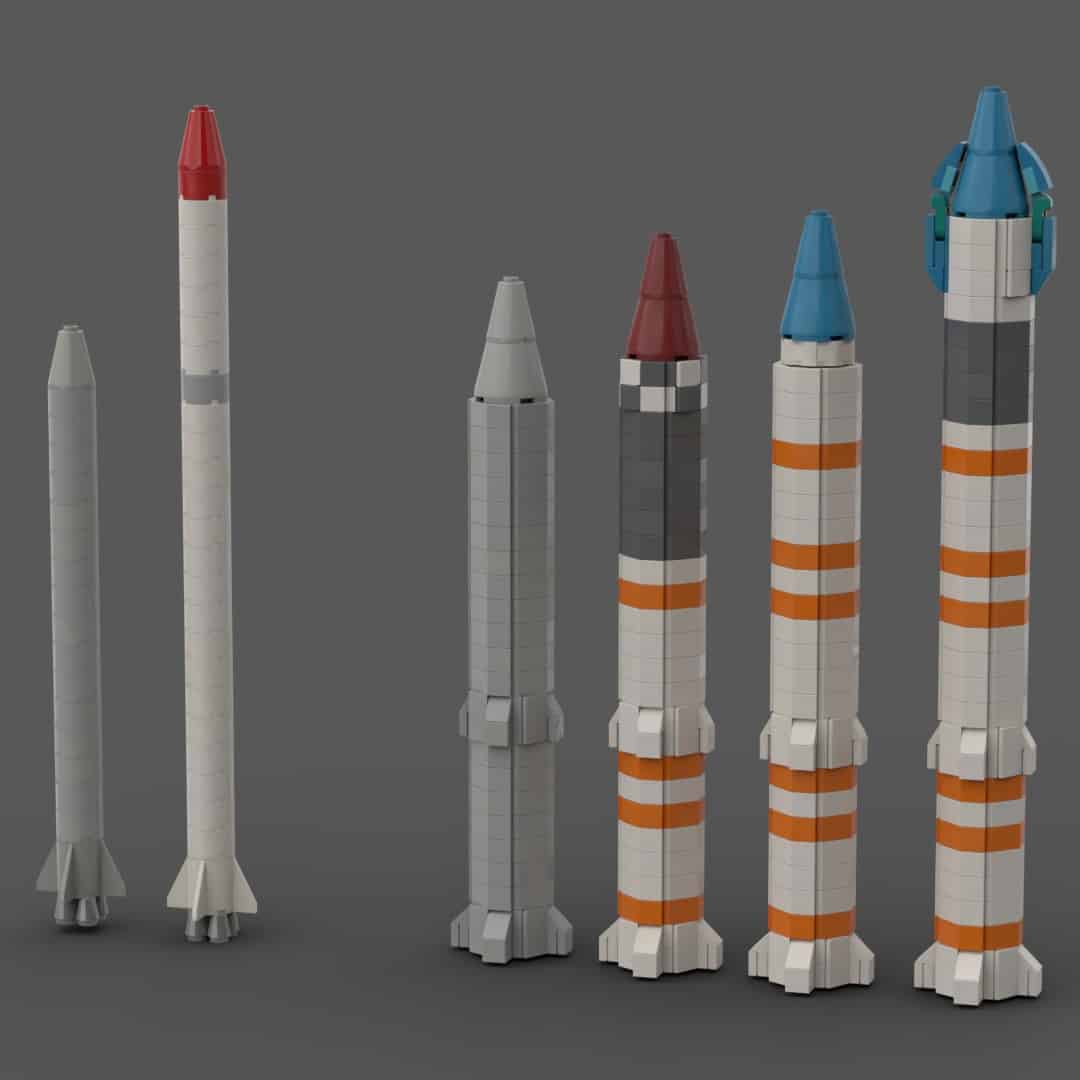
LEGO Designer:
Nicolas Riveau (LegoRocketCollection)
Designed:
June 2020
Categories:
Launch Vehicles, All, Small Lift Launch Vehicles, Space Agency - Roscosmos
Launch Vehicle Details
Stages:
Length:
Diameter:
Mass at Launch:
Low Earth Orbit Capacity:
Total Thrust:
Apogee:
Class:
The Kosmos (also spelled Cosmos, Russian: Ко́смос) rockets were a series of Soviet and subsequently Russian rockets, derived from the R-12 and R-14 missiles, the best known of which is the Kosmos-3M, which has made over 440 launches. The Kosmos family contained a number of rockets, both carrier rockets and sounding rockets, for orbital and sub-orbital spaceflight respectively. The first variant, the Kosmos-2I, first flew on 27 October 1961. Over 700 Kosmos rockets have been launched overall.
R-12
The R-12 Dvina was a ballistic missile developed and deployed by the Soviet Union during the Cold War. The R-12 rocket provided the Soviet Union with the capability to attack targets at medium ranges with a megaton-class thermonuclear warhead and constituted the bulk of the Soviet offensive missile threat to Western Europe. Deployments of the R-12 missile in Cuba caused the Cuban Missile Crisis in 1962.
Kosmos-2I
In 1961, an upper stage using LOX and UDMH propellants was added to the R-12 to create the Kosmos 63S1 booster. Since there were no surface pads for the R-12, all launches took place from the Mayak silo at Kapustin Yar. However, as silos were not designed for repeated use, this arrangement proved impractical and necessitated their refurbishment after every few launches. The first two launch attempts of the 63S1 took place in October and December 1961 and both failed. On March 16, 1962, Kosmos 1, a navigation test satellite, was successfully orbited, marking the first Soviet space launch to be performed with a booster other than the R-7. Finally, a dedicated launch complex was constructed at Kapustin Yar and first used in December 1964.
An enhanced R-12 booster was flown in 1965–67 from the Dvina silo at Kapustin Yar on suborbital tests, eventually giving way to the 11K63, a modernized, improved launch vehicle. In 1967, a second launch complex was opened at Plesetsk and from there on, 11K63 flights alternated between Kapustin Yar and Plesetsk, mostly for orbiting lightweight scientific and military payloads. A total of 123 were flown, of which eight failed to attain orbit. In 1977, the R-12 and 11K63 were retired from use.
R-14
Development of the R-14 began by directive on 2 July 1958. The preliminary design was completed in December 1958, with flight tests beginning in June 1960 and completed in February 1961. The missile was accepted into service on 24 April 1961. Upon introduction, the primary targets of R-14s were Thor missile sites in Britain, Jupiter missile sites in Italy and Turkey, and Polaris missile submarine bases in Spain.
Kosmos 1
The Kosmos-1 was a Soviet carrier rocket, derived from the R-14 missile, which was used to orbit satellites in 1964 and 1965. It served as an interim, and was quickly replaced by the Kosmos-3. Eight were flown, and all launches occurred from Site 41/15 at the Baikonur Cosmodrome.
Kosmos-3
The Kosmos-3 was a Soviet carrier rocket, derived from the R-14 missile, which was used to orbit satellites between 1966 and 1968. It was quickly replaced by the modernised Kosmos-3M. Six were flown, four as orbital carrier rockets, and two on sub-orbital flights. All launches occurred from Site 41/15 at the Baikonur Cosmodrome. The Kosmos-3 made its maiden flight on 16 November 1966, carrying a Strela-2 satellite. Strela-2 satellites were flown on four flights, two of which failed. Two further, sub-orbital launches were conducted with VKZ payloads, both of which were successful.
Kosmos-3M
The Kosmos-3M is a Russian space launch vehicle, member of the Kosmos (rocket family). It is a liquid-fueled two-stage rocket, first launched in 1967 and with over 420 successful launches to its name. The Kosmos-3M uses UDMH fuel and AK27I oxidizer (red fuming nitric acid) to lift roughly 1,400 kg (3,100 lb) of payload into orbit. It differed from the earlier Kosmos-3 in its finer control of the second-stage burn, allowing operators to tune the thrust and even channel it through nozzles that helped orient the rocket for the launching of multiple satellites at one time. PO Polyot has manufactured these launch vehicles in the Russian town of Omsk for decades. It was originally scheduled to be retired from service in 2011 however, in April 2010 the Commander of the Russian Space Forces confirmed that it would be retired by the end of 2010. One further launch, with Kanopus-ST, was planned; however, this was cancelled in late 2012 as the rocket had exceeded its design life while in storage ahead of the launch.
Downloads
Pay what you feel
This digital model is provided free of charge. However, if you like it, and you would like to thank the designer for their time, please consider a “tip” via tipeee.com. A “tip” is voluntary and optional support. It allows you to help creators and tell them that you love their work.
Tips can be made by following this link:
Part count: bricks, lots.
| Unit | width | length | height |
|---|---|---|---|
| Studs | |||
| Inches | |||
| Centimetres |
No external URL provided.
Launch History information from space.skyrocket.de
Launch History information from space.skyrocket.de
Related Posts
None found

